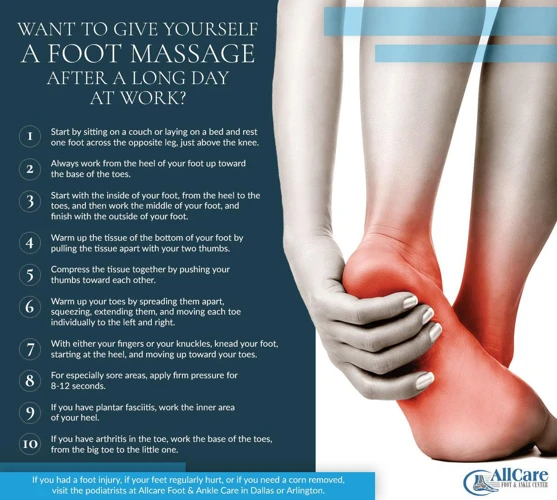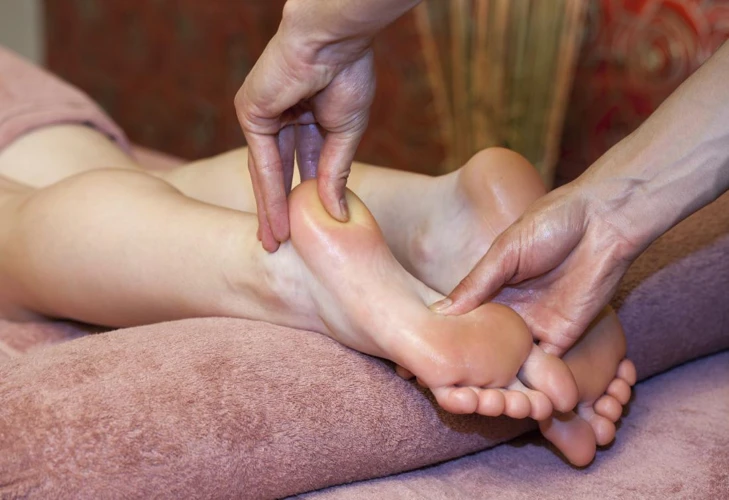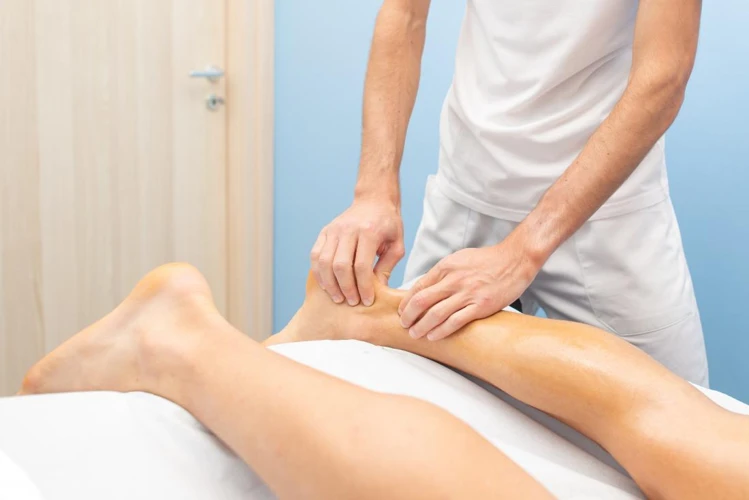Do you want to enjoy the bliss of a relaxing massage without the need to visit a spa? If so, then this guide on how to massage your own feet and legs is the perfect solution for you. Here, we have provided a step-by-step guide to help you give yourself a perfect massage that will reduce muscle tension and improve circulation while providing a calming and soothing experience. Read on to learn how to massage your own feet and legs with ease!
Contents
Benefits of Self-Massage

- Reduces Stress and Anxiety – Massaging your feet and legs can help reduce stress and anxiety as it stimulates the release of endorphins, which is the body’s natural mood enhancer.
- Improves Blood Circulation – Self-massage can help improve blood circulation throughout your body. As massage is done manually, it helps to relax the muscles and encourages the flow of blood.
- Decreases Pain and Tension – Massaging your feet and legs can help to reduce pain and tension in your muscles and joints. Hand massage has been known to provide relief from chronic pain, such as back pain and arthritis.
- Boosts Immunity – Massaging your feet and legs can lead to improved immunity. Massaging the feet and legs stimulates the lymphatic system, which helps your body to flush out toxins, thus boosting your immunity.
- Improves Sleep Quality – Self-massage can help to improve your sleep quality. After a massage, your body is more relaxed and calmer, which can lead to better sleep.
Self-massage of your feet and legs has many benefits, and is an ideal way to relax and reduce stress. A regular foot and leg massage can help to improve your overall wellbeing and give you a sense of relaxation.
Preparing for Foot and Leg Massage

- Warm Up: Start by warming up your feet and legs. You can do this by soaking your feet in a warm foot bath for 10 minutes or applying warm compresses to the area. This will help relax the muscles and make it easier to massage.
- Oil or Cream: To make the massage more comfortable, you can use some oil or cream. This will help the hands glide smoothly over the skin and reduce friction.
- Music: If you want to add some extra relaxation, you can play some soothing music while you massage. This will help you get into a relaxed state of mind and make the massage more enjoyable.
- Pillows: Place some pillows near the massage area. This will help you stay comfortable while you massage and provide support if necessary.
- Lighting: Make sure the area is well lit so that you can easily see what you are doing. Dim lighting can make it difficult to massage properly.
Massaging the Feet

Massaging the Bottom of the Feet
Start by standing and resting one foot on a stool or chair. Using your thumbs and fingers, begin to massage the soles of your feet in a circular motion. Start at the heel, working your way up the arch of your foot and back down. Repeat this process two to three times on each foot.
Massaging the Top of the Feet
Once you have finished massaging the bottom of your feet, move to the top. Again, using your thumbs and fingers, massage the top of your feet in a circular motion. Start at the toes, working your way up to the ankle and back down. Repeat this process two to three times on each foot.
Massaging the Heels and Toes
Once you have finished massaging the top of your feet, focus on the heels and toes. Massage each heel individually, using a circular motion. Next, massage each toe individually, using a circular motion. Repeat this process two to three times until you feel relaxed.
Massaging the Legs

Massaging the Calves: Start with your feet, using your thumbs to massage your calves in circular motions. Don’t forget to use some pressure, but be careful not to press too hard as it can be painful. Move up to your knees and use your thumbs to massage along the sides of your legs.
Massaging the Thighs: Apply pressure with your thumbs, kneading the flesh in an up-and-down motion. Move your thumbs in broad circles, and then move to the other side of the leg. Finally, use your fingers to massage the back of your thigh, lightly rubbing the area in a circular motion.
Practicing Self-Massage Techniques

- Increases circulation: Massaging your feet and legs can help improve circulation and reduce inflammation.
- Relieves tension: The pressure of the massage helps to relieve tension and tightness in muscles and joints.
- Helps you relax: Massage can also be used as a form of relaxation and can help reduce stress and anxiety levels.
- Improves mobility: Regular massage can help improve your range of motion and flexibility.
- Boosts immunity: Massage helps to increase the production of white blood cells, which helps to boost your overall immunity.
Tips and Tricks for Self-Massage
- Start with gentle strokes: Begin your self-massage by using gentle strokes to warm up the muscles and increase circulation. This will help your muscles to relax and become more receptive to deeper pressure.
- Use essential oils: Essential oils can add an extra layer of relaxation to your self-massage. Lavender, eucalyptus, and rosemary are some of the best oils to use when giving yourself a massage.
- Try different techniques: There are many different massage techniques you can use to relax your body. Experiment with kneading, tapping, and circular motions to find the ones that work best for you.
- Focus on pressure points: Pressure points are areas of the body that are especially sensitive to massage. Focusing on these points can help to relieve tension and stimulate healing. The soles of your feet, behind your ears, and the temples are common pressure points.
- Be mindful of your breathing: Pay attention to your breathing throughout your self-massage. Take deep, slow breaths to enhance relaxation and release tension. Mindful breathing can also help you to stay in the moment and focus on the sensations of the massage.
- Take breaks as needed: Self-massage should never be uncomfortable. If you find that an area is too tender or sensitive, take a break. Give yourself time to relax and adjust before continuing.
Frequently Asked Questions
What kind of massage oil should I use for my feet and legs?
Olive oil: Olive oil is a great choice for massage oil as it is rich in antioxidants and helps nourish the skin. It also has a pleasant aroma and can be used as a base for other essential oils.
Coconut oil: Coconut oil is a great choice for massage oil as it is rich in vitamins and minerals, and helps keep the skin moisturized. It is also light and absorbs easily into the skin.
Almond oil: Almond oil has anti-inflammatory properties, which makes it a great choice for massaging sore and tired muscles. It is also light and absorbs easily into the skin.
Grapeseed oil: Grapeseed oil is light and non-greasy, making it an ideal choice for massaging feet and legs. It is also rich in vitamin E, which helps nourish the skin.
Jojoba oil: Jojoba oil is a great choice for massaging feet and legs because it is non-greasy and absorbs easily into the skin. It also helps keep the skin moisturized and nourished.
Essential oils: Essential oils are a great addition to any massage oil blend, as they can help soothe and relax the body. Popular essential oils for foot and leg massages include lavender, rosemary, peppermint, and eucalyptus.
Is it Safe to Massage My Own Feet and Legs?
Yes, it is safe to massage your own feet and legs. In fact, it can be very beneficial and help improve circulation, reduce stress and tension, and help relax the muscles. However, it is important to use the correct technique and avoid putting too much pressure on the feet or legs. Be sure to use gentle, circular strokes and avoid any jerky or rough movements. You should also be sure to take breaks if your feet or legs become sore or uncomfortable.
How often should I massage my feet and legs?
Massaging your feet and legs can be beneficial for your overall wellbeing and relaxation. To get the most out of your massage sessions, it is recommended to massage your feet and legs 1-2 times a week. It is also important to maintain a good balance between massage and rest, as over-massaging can lead to discomfort and inflammation.
Does Foot Massage Help With Chronic Pain or Injury?
Foot massage is known to provide relief from chronic pain and injuries. It can be used to help reduce pain, improve circulation, and increase relaxation. Studies have found that foot massage can reduce pain and improve function in people with chronic pain, such as arthritis. Additionally, foot massage can help reduce inflammation, improve range of motion, and improve muscle strength. It is also thought to help reduce stress and anxiety.
Will I Need Any Special Equipment to Massage My Own Feet and Legs?
No special equipment is necessary for self-massage. All that is required is a comfortable surface and the use of your hands. However, you can use props like a foam roller, massage balls, and other tools to help you reach and massage areas that your hands may have difficulty accessing.
Conclusion
Self-massage is an effective way to relax tense muscles and relieve stress. By following the steps in this guide, you can massage your feet and legs to achieve perfect relaxation. Make sure to remember to be gentle and to not overexert yourself. With regular practice, you can master self-massage and reap the benefits of improved comfort and relaxation.

